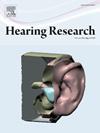刺激水平对人工耳蜗模型中多说话人噪声语音掩蔽的影响
IF 2.5
2区 医学
Q1 AUDIOLOGY & SPEECH-LANGUAGE PATHOLOGY
引用次数: 0
摘要
以往的研究表明,在一定的语音噪声比下,语音的可理解度随整体刺激水平的变化而变化。据推测,这些变化与耳蜗基底膜的非线性反应有关,然而,听觉外周在这种行为中的确切作用尚不清楚。我们使用一个具有可调增益的非线性耳蜗模型来研究多说话者(咿呀学语)噪声如何影响听觉外围输出的语音信号。通过将模型响应与单独的语音和SIN(恒定的语音噪声比为- 5 dB)相关联来计算由牙牙学噪声引起的各种强度的失真量。模型显示,在30 ~ 60 ~ 70 dB声压级范围内,5%分位数和互相关系数均值均随刺激强度的增大而增大,在70 ~ 90 dB声压级范围内则依次减小,表明在中等强度下,牙牙学语噪声的掩蔽效果较差,而在低、高强度下,其影响均最强。此外,耳蜗放大器增益的降低降低了相互关系,导致信号可理解性恶化。总之,虽然不排除可能的中心贡献,但我们的结果提供了一个合理的外周机制,表明SIN可理解性的水平依赖已经起源于外周加工,并且耳蜗放大在这一过程中起着重要作用。本文章由计算机程序翻译,如有差异,请以英文原文为准。
Effect of stimulus level on speech masking by multitalker noise in a cochlear model
Previous research shows that intelligibility of speech in noise (SIN) with a constant speech-to-noise ratio (SNR) changes in dependence on overall stimulus level. It has been hypothesized that these changes were associated with nonlinear responses of the cochlear basilar membrane, however, the exact role of auditory periphery in this behavior is not clear. We explore this phenomenon using a nonlinear cochlear model with adjustable gain to examine how multi-talker (babble) noise affects the speech signal at the output of the auditory periphery. The amount of distortion at various intensities caused by babble noise is calculated by correlating the model responses to speech alone and to SIN with a constant speech-to-noise ratio of −5 dB. The model shows that both 5% quantile and the mean value of the cross-correlation coefficient increase with stimulus level from 30 to 60–70 dB SPL and then decline for levels between 70 dB and 90 dB SPL, indicating that babble noise represents a less effective masker at intermediate intensities and its influence is strongest at both low and high levels. In addition, reduction of the gain of the cochlear amplifier decreases the cross-correlation, leading to worsened SIN intelligibility. Altogether, while not ruling out possible central contributions, our results offer a plausible peripheral mechanism suggesting that the level dependence of SIN intelligibility has its origins already in peripheral processing and that cochlear amplification plays an important role in this process.
求助全文
通过发布文献求助,成功后即可免费获取论文全文。
去求助
来源期刊

Hearing Research
医学-耳鼻喉科学
CiteScore
5.30
自引率
14.30%
发文量
163
审稿时长
75 days
期刊介绍:
The aim of the journal is to provide a forum for papers concerned with basic peripheral and central auditory mechanisms. Emphasis is on experimental and clinical studies, but theoretical and methodological papers will also be considered. The journal publishes original research papers, review and mini- review articles, rapid communications, method/protocol and perspective articles.
Papers submitted should deal with auditory anatomy, physiology, psychophysics, imaging, modeling and behavioural studies in animals and humans, as well as hearing aids and cochlear implants. Papers dealing with the vestibular system are also considered for publication. Papers on comparative aspects of hearing and on effects of drugs and environmental contaminants on hearing function will also be considered. Clinical papers will be accepted when they contribute to the understanding of normal and pathological hearing functions.
 求助内容:
求助内容: 应助结果提醒方式:
应助结果提醒方式:


